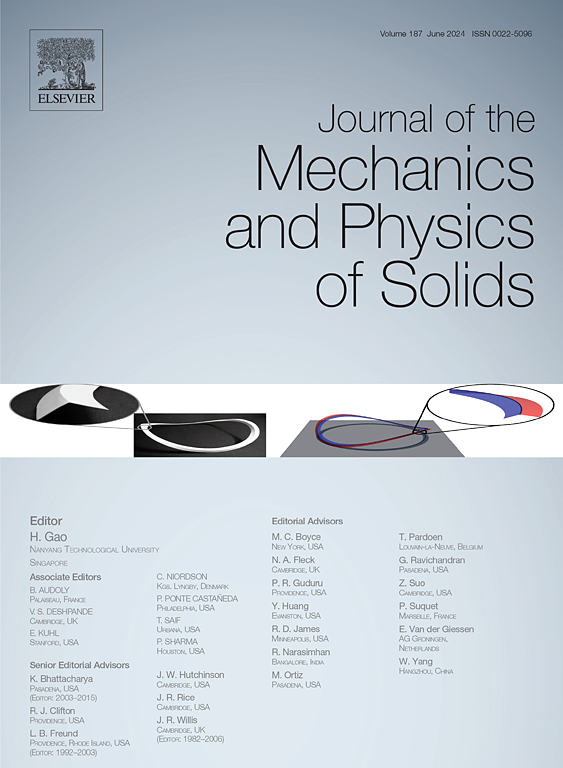A deformation-based unified theory for composite plates
IF 6
2区 工程技术
Q2 MATERIALS SCIENCE, MULTIDISCIPLINARY
引用次数: 0
Abstract
A deformation-based unified theory (DUT) for composite plates is established. The new theory contains four unknown displacement components that are explicit and can be interpreted with physical reasoning. Apart from the three common displacement components for a point on the reference plane, the remaining higher-order displacement component is exclusively attributed to the transverse bending and shear deformations. The elucidation of the thickness locking mechanism (TLM) relies on the innovative displacement component introduced in this study, which improves the kinematic assumptions inherent in conventional plate theories. The transverse shear deformation of the function distribution for composite plates can be described by a general thickness function, thus enabling DUT to be degenerated into any existing shear deformation plate theory. Further, the present plate theory explains the physical terms associated with transverse normal stress and strain. The present unified theoretical framework, along with the corresponding assumptions, can induce further simplification and transition to existing plate theories, namely, classical plate theory (CPT), first-order shear deformation theory (FSDT), and third-order shear deformation theory (TSDT). Exact analytical solutions of laminated composite plates are obtained. Comprehensive numerical results are presented for various plate theories and different plate structures. The clarity and unity in the physical interpretation of the present theory can be elaborated by integrating the conventional theories under certain assumptions. In addition, the extensive applicability of the theoretical framework of DUT enables the customization of the kinematic modeling of various composite plate structures.

基于变形的复合板统一理论
建立了基于变形的复合材料板统一理论。新理论包含四个未知的位移分量,它们是明确的,可以用物理推理来解释。除了参考平面上点的三个常见位移分量外,其余的高阶位移分量完全归因于横向弯曲和剪切变形。厚度锁定机制(TLM)的解释依赖于本研究中引入的创新位移分量,它改进了传统板理论中固有的运动学假设。复合材料板的横向剪切变形函数分布可以用一般的厚度函数来描述,从而使被测件退化为任何现有的剪切变形板理论。此外,目前的板块理论解释了与横向法向应力和应变有关的物理术语。目前统一的理论框架以及相应的假设可以进一步简化和过渡到现有的板块理论,即经典板块理论(CPT)、一阶剪切变形理论(FSDT)和三阶剪切变形理论(TSDT)。得到了复合材料层合板的精确解析解。给出了各种板理论和不同板结构的综合数值结果。现有理论的物理解释的清晰性和统一性可以通过在某些假设下整合传统理论来阐述。此外,DUT理论框架的广泛适用性使得各种复合板结构的运动学建模可以定制。
本文章由计算机程序翻译,如有差异,请以英文原文为准。
求助全文
约1分钟内获得全文
求助全文
来源期刊
CiteScore
9.80
自引率
9.40%
发文量
276
审稿时长
52 days
期刊介绍:
The aim of Journal of The Mechanics and Physics of Solids is to publish research of the highest quality and of lasting significance on the mechanics of solids. The scope is broad, from fundamental concepts in mechanics to the analysis of novel phenomena and applications. Solids are interpreted broadly to include both hard and soft materials as well as natural and synthetic structures. The approach can be theoretical, experimental or computational.This research activity sits within engineering science and the allied areas of applied mathematics, materials science, bio-mechanics, applied physics, and geophysics.
The Journal was founded in 1952 by Rodney Hill, who was its Editor-in-Chief until 1968. The topics of interest to the Journal evolve with developments in the subject but its basic ethos remains the same: to publish research of the highest quality relating to the mechanics of solids. Thus, emphasis is placed on the development of fundamental concepts of mechanics and novel applications of these concepts based on theoretical, experimental or computational approaches, drawing upon the various branches of engineering science and the allied areas within applied mathematics, materials science, structural engineering, applied physics, and geophysics.
The main purpose of the Journal is to foster scientific understanding of the processes of deformation and mechanical failure of all solid materials, both technological and natural, and the connections between these processes and their underlying physical mechanisms. In this sense, the content of the Journal should reflect the current state of the discipline in analysis, experimental observation, and numerical simulation. In the interest of achieving this goal, authors are encouraged to consider the significance of their contributions for the field of mechanics and the implications of their results, in addition to describing the details of their work.

 求助内容:
求助内容: 应助结果提醒方式:
应助结果提醒方式:


